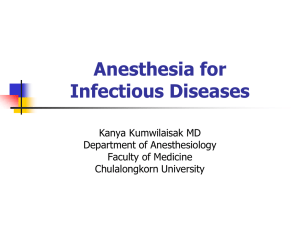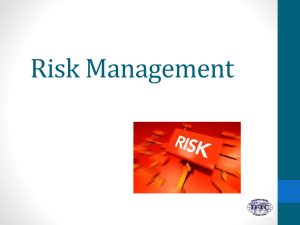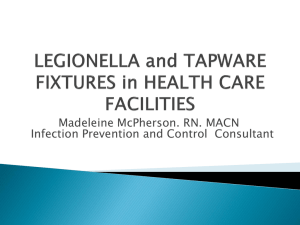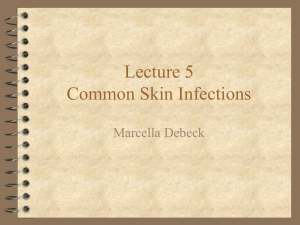12920 KB - I-Tech
advertisement
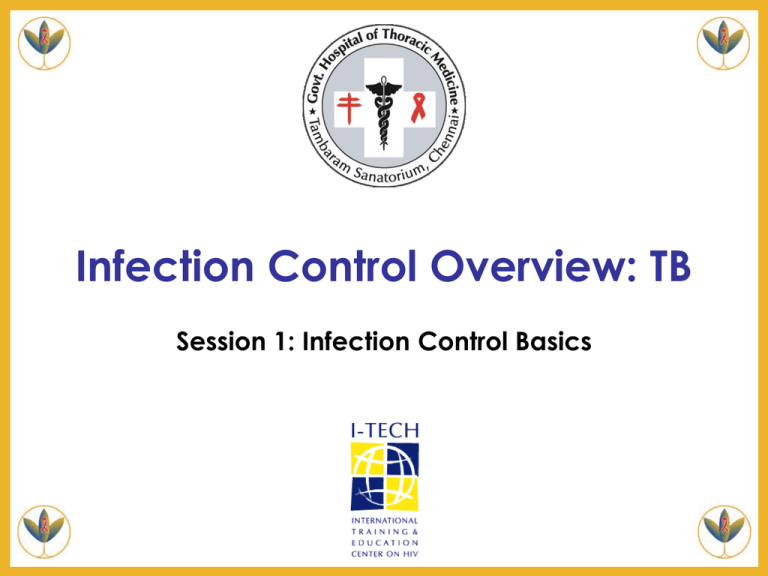
Infection Control Overview: TB Session 1: Infection Control Basics Learning Objectives This session deals with the control of TB By the end of the session, participants will be able to protect themselves and others from TB 1: Infection Control Overview - TB Slide 2 Steps to Prevent the Spread of TB to Staff and Patients Detect infectious patients early Ensure cross ventilation and wear masks during coughinducing procedures Leave windows open and direct air flow from staff to patients Separate AFB smear positive patients from others Instruct patients to turn their head and cover their mouth when coughing 1: Infection Control Overview - TB Slide 3 Early Detection and Treatment of TB Protects You! TB is the greatest hazard nurses face Most infections are passed from patients, visitors and staff whom no one suspects of having TB 1: Infection Control Overview - TB Slide 4 Our visitor has been coughing for three weeks and is losing weight! 1: Infection Control Overview - TB Slide 5 Doctor, we are sending you a person to be evaluated for TB. Please let us know when she can come back to the ward 1: Infection Control Overview - TB Slide 6 Have Chronic Coughs Evaluated A cough greater than 3 weeks should be evaluated whether in you, another staff member, a visitor, a volunteer, family member or patient Act early! 1: Infection Control Overview - TB Slide 7 Discussion: Tuberculosis and Nurses What are the tasks that puts you at most risk for contracting TB? 1: Infection Control Overview - TB Slide 8 Cough Producing Procedures that put HealthCare Personnel at Risk Bronchoscopy 1: Infection Control Overview - TB Slide 9 Cough Producing Procedures that put HealthCare Personnel at Risk (cont’d) Getting a sputum specimen 1: Infection Control Overview - TB Slide 10 Cough Producing Procedures that put HealthCare Personnel at Risk (cont’d) Suctioning 1: Infection Control Overview - TB Slide 11 Cough Producing Procedures that put HealthCare Personnel at Risk (cont’d) Nebuliser treatments 1: Infection Control Overview - TB Slide 12 What are the Risks Involved in these Procedures? Surgery Placing intercostal drains Handling mycobacterium cultures Cleaning suction cups Post-mortem 1: Infection Control Overview - TB Slide 13 Discussion: High Risk Procedures Before proceeding for bronchoscopy, what precautions should you follow? In what way may you be putting yourself or your patients at risk? How could this be improved? How is this similar or different from other high-risk procedures? 1: Infection Control Overview - TB Slide 14 TB (N95) Masks TB masks should be used during high risk procedures: 1: Infection Control Overview - TB N95 mask has a filter efficiency of 95% Can be reused until contaminated or clogged Must be discarded when breathing becomes difficult Slide 15 Do other Masks Help? A paper or cloth mask can get wet in as little as 10 minutes, allowing bacteria to pass If mask is not tight over the nose and mouth, unfiltered air will be sucked in around the nose and cheeks What is more important than masks? Early detection and treatment Good ventilation Isolation of pulmonary TB cases 1: Infection Control Overview - TB Slide 16 Other Factors that put Staff at Risk: No cross breeze Patients care areas without 2 open facing windows DANGER: Bronchoscopy suite without windows or outside airflow 1: Infection Control Overview - TB Slide 17 Protect Yourself with Good Ventilation Open windows See patients in rooms with a window on each side of the room 1: Infection Control Overview - TB Slide 18 Protect Yourself with Good Ventilation (cont’d) Health worker Patient Proper Airflow Direction 1: Infection Control Overview - TB Slide 19 Open window How can you Reduce the Risk of TB for these Staff? Nurse placing PPD’s in center of the office Clerical staff entering records behind in office near window 1: Infection Control Overview - TB Slide 20 Instruct Coughing Patients to Turn their Heads, and Cover their Mouths Cover the mouth with a cloth, a sleeve or a sari to stop germs going into the air 1: Infection Control Overview - TB Slide 21 Protecting Yourself and Others from TB Separate infectious TB (smear + or smears pending) patients from other patients Staff who do not work directly with patients should not enter areas with infectious TB patients 1: Infection Control Overview - TB Slide 22 Which is the Most Dangerous Mix of Patients and Why? HIV - and HIV + Smear + TB and HIV + MDRTB smear + and HIV+ MDRTB smear + and HIV - 1: Infection Control Overview - TB Low risk Slide 23 High risk Greatest Risk! High risk Don’t Mix Non-Infectious TB and Infectious TB Patients Questions for discussion: When do we consider people non-infectious? What precautions should we take with patients who are on ARVs? 1: Infection Control Overview - TB Slide 24 MDRTB Patients Should not Mix with other Patients Multiple drug resistant TB (MDRTB) is not treatable by first line treatment 50% or more who develop MDRTB disease will die These patients must not be in the same building as uninfected persons Patients in a hospital can infect more people than at home 1: Infection Control Overview - TB Slide 25 Summary: Steps to Protect Yourself and Others from TB Ensure a cross breeze, open windows and the direction of air flow from the health care worker to the patient to outside Separate non-infected patients from patient who are, or might be infectious Have patients turn their head and cover their mouth when they cough Keep non-essential staff out of areas with infectious patients or cough-inducing procedures 1: Infection Control Overview - TB Slide 26 Key Points Preventing the spread of TB includes: Early detection and treatment Strict isolation of smear positive patients Good ventilation Extra precautions during cough inducing procedures Attention to patient placement Teaching cough hygiene 1: Infection Control Overview - TB Slide 27 BREAK




